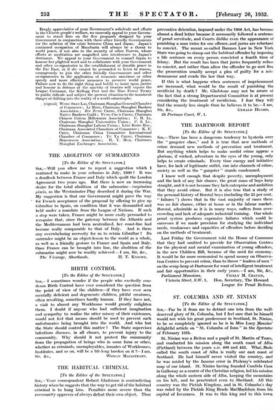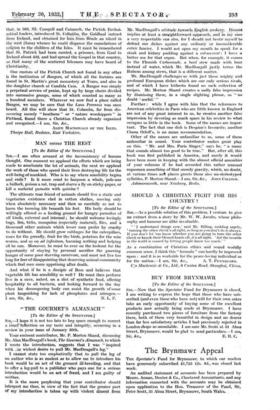ST. COLUMBA AND ST. NINIAN
[To the Editor of the SPECTATOR.] SIR,—Far be it from me to detract one iota from the well- deserved glory of St. Columba, but I feel sure that he himself would not wish his great predecessor in Scotland, St. Ninian, to be so completely ignored -as he is in Miss Lucy, Menzies' delightful article on " St. Columba of Iona " in the Spectator of February 13th.
St. Ninian was a Briton and a pupil of St. Martin of Tours, and conducted his mission along the south coast of Alba (Pictland) between the years A.D. 400 and 432. What.Bede called the south coast of Alba is really our east coast of Scotland. He had himself never visited the country, and lie was misled by the famous error in Ptolemy's celebrated map of our island. St. Ninian having founded Candida Casa in Galloway as a centre of the Christian religion, led his mission along the whole eastern side of Alba, keeping the mountains on his left, and he penetrated even- to °Shetland. All this country was the Pictish Kingdom, and in St. Columba's day was ruled by the Pictish King litude Mac11.1aelehon from his capital of Inverness. It was to this king and to this town
that, in 563, SS. Comgall and Cainnech, the Pictish Ecclesi- astical leaders, introduced St. Coliuhlxi, the Gairlheal outcast from Ireland, and obtained for iiiirf.finmDrude an island in the west (Iona) whence he could dispense the consolations of religion to the ehildren ofthe Isles. It must be remembered that St. Patrick had been carried, a prisoner, from Gaul to Ireland about 432, and had spread the Gospel in that country, so that many of the scattered Islesmen may have heard of Christidnity..
One custom of the Pictish Church not found in any other is the institution of Bangors, of which all the features are found in St. Martin's great monastery at Tours, and also in the daughter church at Candida Cilia. A Bangor was simply a perpetual service of praise, kept up by large choirs divided into successive groups, some of which counted as many as a hundred members. Wherever we now find a place called Ihingor, we may be sure that the Lam Perennis was once heard. All this will show that St. Columba, far from dis- covering merely " heathens " or " nature worshippers " in Pictland, found there a Christian Church already organized and recognized.—I am, Sir, &e.,







































 Previous page
Previous page